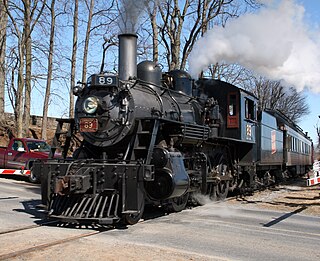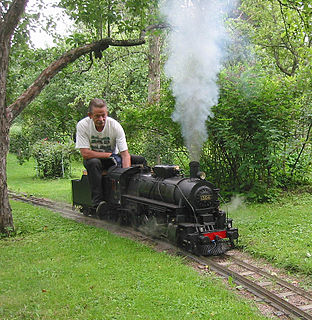Related Research Articles

A construction foreman or construction forewoman is the worker or skilled tradesperson who is in charge of a construction crew. This role is generally assumed by a senior worker.

The Safety Appliance Act is a United States federal law that made air brakes and automatic couplers mandatory on all trains in the United States. It was enacted on March 2, 1893, and took effect in 1900, after a seven-year grace period. The act is credited with a sharp drop in accidents on American railroads in the early 20th century.

George Washington Whistler was a prominent American civil engineer best known for building steam locomotives and railroads. He is credited with introducing the steam whistle to American locomotives.

Under the Whyte notation for the classification of steam locomotives, 2-6-0 represents the wheel arrangement of two leading wheels on one axle, usually in a leading truck, six powered and coupled driving wheels on three axles and no trailing wheels. This arrangement is commonly called a Mogul.

The Little Joe is a type of railroad electric locomotive built by General Electric. The locomotives had twelve axles, eight of them powered, in a 2-D+D-2 arrangement. They were originally intended to be exported to the Soviet Union and designed to operate on Soviet Railways (SZhD) 3,300-volt DC overhead line system, however, they were never exported to the Soviet Union due to rising political tensions between the United States and the Soviet Union. Only 20 were built, with 15 sold to domestic operators and 5 exported to Brazil.

A fireman, stoker or watertender is a person whose occupation it is to tend the fire for the running of a boiler, heating a building, or powering a steam engine. Much of the job is hard physical labor, such as shoveling fuel, typically coal, into the boiler's firebox. On steam locomotives the title fireman is usually used, while on steamships and stationary steam engines, such as those driving saw mills, the title is usually stoker. The German word Heizer is equivalent and in Dutch the word stoker is mostly used too. The United States Navy referred to them as watertenders.

Live steam is steam under pressure, obtained by heating water in a boiler. The steam is used to operate stationary or moving equipment.

The EMD GP7 is a four-axle (B-B) diesel-electric locomotive built by General Motors Electro-Motive Division and General Motors Diesel between October 1949 and May 1954.

The Roaring Camp & Big Trees Narrow Gauge Railroad is a 3 ft narrow-gauge tourist railroad in California that starts from the Roaring Camp depot in Felton, California and runs up steep grades through redwood forests to the top of nearby Bear Mountain, a distance of 3.25 miles.
The South Simcoe Railway is a steam heritage railway in Tottenham, Ontario, north of Toronto. Operating excursions since 1992, it is the oldest operating steam heritage railway in Ontario and features the second oldest operating steam locomotive in Canada.

A train driver, engine driver, engineman or locomotive driver, commonly known as an engineer in the United States and Canada, and also as a locomotive handler, locomotive operator, train operator, or motorman, is a person who drives a train, multiple unit or a locomotive. The driver is in charge of, and responsible for the mechanical operation of the train, train speed, and all train handling. In American English, a hostler moves engines around train yards, but does not take them out on the normal tracks; the British English equivalent is a shunter.
A foreman, forewoman or foreperson is a supervisor, often in a manual trade or industry.

An oiler is a worker whose main job is to oil machinery. In previous eras there were oiler positions in various industries, including maritime work, railroading, steelmaking, and mining. Today most such positions have been eliminated through technological change; lubrication tends to require less human intervention, so that workers seldom have oiling as a principal duty. In the days of ubiquitous plain bearings, oiling was often a job description in and of itself.
A freight conductor is a person who is employed by a railroad. The freight conductor is the lead employee assigned to a freight train, and is responsible for the smooth operation of the assignment, which includes reviewing schedules and maintaining communication with the train's crew members.

A Bahnbetriebswerk is a German railway depot where the maintenance of locomotives and other rolling stock is carried out. It is roughly equivalent to a locomotive shed, running shed or motive power depot. These were of great importance during the steam locomotive era to ensure the smooth running of locomotive-hauled services. Bahnbetriebswerke had a large number of facilities in order to be able to carry out their various maintenance tasks. As a result, they needed a lot of staff and were often the largest employers in the area.

The Burlington railroad strike of 1888 was a failed union strike which pitted the Brotherhood of Locomotive Engineers, the Brotherhood of Locomotive Firemen, and the Switchmen's Mutual Aid Association (SMAA) against the Chicago, Burlington and Quincy Railroad (CB&Q) its extensive trackage in the Midwestern United States. It was led by the skilled engineers and firemen, who demanded higher wages, seniority rights, and grievance procedures. It was fought bitterly by management, which rejected the very notion of collective bargaining. There was much less violence than the Great Railroad Strike of 1877, but after 10 months the very expensive company operation to permanently replace all the strikers was successful and the strike was a total defeat for them.

The 1990 Back Bay, Massachusetts train collision was a collision between an Amtrak passenger train, the Night Owl, and a Massachusetts Bay Transportation Authority (MBTA) Stoughton Line commuter train just outside Back Bay station in Boston, Massachusetts, United States. An investigation by the National Transportation Safety Board (NTSB) found that the Amtrak train entered a speed-restricted curve at excessive speed, causing the train to derail and crash into the MBTA commuter train on an adjacent track. Although no one was killed in the accident, 453 people were injured and Back Bay station was closed for six days. Total damage was estimated at $14 million. The accident led to new speed restrictions and safety improvements in the vicinity of Back Bay and a revamp of Amtrak's locomotive engineer training program.
Henry Roe Campbell was an American surveyor and civil engineer. Campbell contributed to American railroading and bridge-building in the first half of the 19th century. Campbell patented his 4-4-0 design in February 1836, just a few months before the patent law was changed to require that claims include proof of originality or novelty.
Steele v. Louisville & Nashville Railway Co., 323 U.S. 192 (1944), is a US labor law case, concerning the responsibility of every formally recognized labor organization, to equally represent all the members of whatever is/are the particular class(es) or craft(s) of an employer's Fair Labor Standards Act (FLSA) covered employees regardless of whether any particular individual(s) are, or are not, members of the duly recognized labor organization labor unions.
References
- ↑ "Road Foreman of Engines - PTC". Herzog. Linkedin. Retrieved 2020-04-18.